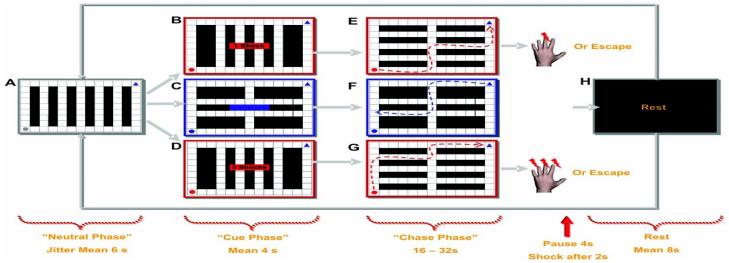Fig. 1.
The virtual predator and prey paradigm. Subjects were presented with a two-dimensional maze containing a 9 × 13 rectangle grid of walls (black squares) and paths (white squares). All experimental conditions commenced with a “neutral phase” where a preprogrammed artificially intelligent (AI) gray circle (AIneutral) appeared at the left-bottom side of the maze (A). The AIneutral was presented on average for 6 s (jitter ± 2 s) and programmed to wander the maze indiscriminately. After this, the “cue phase” commenced with the AIneutral changed into a predator (AIpredator) or a yoked control condition. The change from AIneutral to AI predator was signaled by the circle flashing between red and gray. The flashing AIpredator appeared for 2 s, and during this time it wandered the maze indiscriminately. Directly after this, subjects were also informed for 2 s of the amount of cutaneous electrical shock they would receive if the AIpredator captured them: (B) one shock (AIlow predator), (C) no shock, or (D) three shocks(AIhigh predator).
During the cue phase, subjects were passive and unable to move the blue triangle situated in the upper right corner of the maze. The “chase phase” began with the AIpredator ceasing to flash and the subject moving the blue triangle to (E) escape the AIlow predator, (F) mimic the movements of the triangle in a replay of a previous experimental condition, or (G) escape the AIhigh predator. (H)
After escape or capture, a rest period was presented before the onset of the next trial. To ensure that subjects would not anticipate the end of the chase, we randomly varied the time each AIpredator encounter was played (e.g., 16, 20, 24, 28, 32 s). The subjects were not informed that the length of trials varied or given any indication of how much time they had on each trial. To enhance the feelings of spatial distance, mazes were intentionally designed so that chases were long unimpeded runs with no dead-ends. Each block was interleaved with 8, 10, or 12 s of black screen. Further details can be found in the supporting online material.

